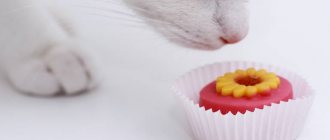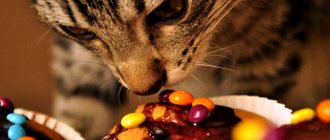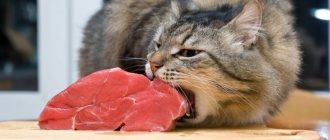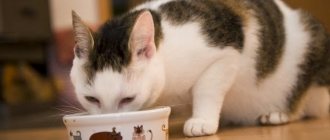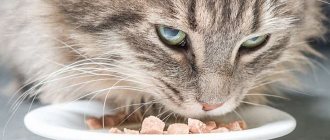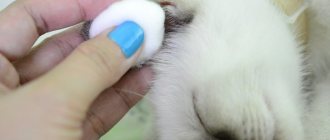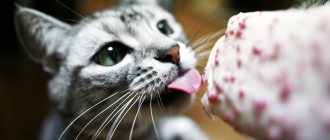Physiology of taste in cats
When a cat receives a piece of chocolate or caramel or ice cream from the owner’s hands, it, at first glance, eats the sweets with pleasure. In fact, she is attracted to the fats and dairy products found in treats. But the taste itself remains uncertain for the pet; it does not feel it and does not receive the pleasure characteristic of a person.
The reason for this phenomenon is explained by the absence of the Tas 1r2 gene in cats. It is its content in the blood of mammals that is responsible for the craving for sweets.
For cats, animal proteins, found in large quantities in meat, are a treat, and sugar and all its derivatives are just a by-product found in ice cream and chocolate.
A cat can recognize any protein with amazing ease. It is noteworthy that wild feline predators are able to determine by smell whether the prey they hunt is alive, injured, or already dead.
And since cats are not able to recognize sugar, they do not feel and do not control the amount of its consumption. Therefore, they can easily exceed the safe dose, which is actually very low. There is only one way out - do not give sweets to cats at all.
If in tiny quantities sweets are simply useless for cats, then at the slightest excess of the norm it becomes very dangerous.
Why not"
There are several reasons why your pet should be protected from sweets from the home table. The first is dental. The enamel of a cat's teeth is approximately 10 times thinner than that of a human. And therefore, oral bacteria, which actively grow precisely when exposed to sugars, are capable of causing really serious damage to tooth enamel, including the development of caries, periodontitis, and so on.
The second is dietary. All sweets, by definition, are very high in calories, and an animal that receives it on a regular basis, as a rule, goes beyond its normal weight. Simply put, the pet gets fat, which is fraught with corresponding health complications.
The third is gastroenterological. It is known that excess sugars in a pet’s body can cause diarrhea and upset the balance of gastrointestinal microflora, causing excessive growth of bacteria in the intestines.
Finally, cats simply do not understand the pleasure that humans get from eating the same food containing sugar. The reason is simple: these animals do not have sweet taste receptors.
Although in fairness it should be noted that pets may show interest in some confectionery products - for example, ice cream or condensed milk. In such cases, cats are attracted to their high fat content rather than their sweetness.
What is the harm of sweets for a cat?
The most dangerous sweet for cats is chocolate. The content of the alkaloid theobromine in cocoa beans is very high. When it enters the cat's body in small doses, a jump in blood pressure occurs, the animal develops tachycardia, and abnormal agitation appears.
If a cat consumes chocolate excessively, poisoning quickly occurs, which most often ends in death. Since the animal’s kidneys and liver accumulate this alkaloid, but are not capable of decomposing it and removing it from the body. But any product containing sugar is no less harmful to the cat. The carbohydrate content in it is very high; the cat has no need for such concentrations in the blood.
The carbohydrate that an animal receives from dry food or natural healthy food is quite sufficient for the normal functioning of the body. And the excess is deposited in the form of fat reserves - subcutaneous and, what is much worse, on the walls of internal organs, which leads to obesity of the liver, kidneys, and other body systems.
It is especially dangerous to give sweets to young animals, elderly pets, pregnant and lactating females, and animals with chronic diseases.
In old animals, sweets will sharply increase the fragility of blood vessels. And eating chocolate by pregnant cats can lead to miscarriages, the development of fetal pathologies and the birth of stillborn kittens.
Harmful sweets
Even if sugar itself is not toxic to a cat, other ingredients in candy and other human treats can threaten its health.
Such substances include:
Xylitol and other artificial sweeteners: Xylitol is commonly found in sugar-free gum and mints and is less commonly added to other candies and drinks. This sweetener can cause stomach upset, liver and blood sugar changes, seizures, and even death in your pet.
Chocolate and caffeine : Chocolate is harmful to animals. The darker it is, the more dangerous it is to their health. Consumption of chocolate and caffeine leads to problems with the gastrointestinal tract, promotes the development of muscle tremors, cramps and arrhythmia (heart rhythm disturbances), and in severe cases, causes death.
Raisins and grapes : fresh grapes and their dried fruits can cause kidney failure.
Sweets and cat diseases
The first thing that can happen to a pet when eating sweets is a decrease in immunity and the development of many serious diseases.
Immune defense disorders
Even a small piece of chocolate can cause severe poisoning in a cat. And if everything seems to have gone well, the consequences may be distant.
The immune system was damaged in any case. And against the background of this disorder, allergic reactions may occur, diseases of the oral cavity may appear, numerous redness, ulcers and sores form on the gums, itching of the skin, hair loss begins and the development of alopenia.
Chocolate, sweets, and cakes can also cause a deterioration in a cat’s vision, including blindness, as well as cause diarrhea and vomiting, and increased salivation.
Decreased immunity undermines the cat's body's defenses. The animal becomes susceptible to colds and viral diseases, otitis media and conjunctivitis, fungal infections of any organs.
The digestive system also suffers, the animal develops a false feeling of fullness, and the digestibility of animal protein deteriorates. Oxygen saturation of tissues decreases, and the aging process of the entire organism as a whole accelerates.
Urolithiasis disease
Cats' kidneys are the first to suffer when they eat sweets. Due to intensive work (after all, this is a purification system that unsuccessfully tries to remove harmful products from the body), they significantly increase in size.
The animal's organs are subject to wear and tear, and the acid-base balance is disturbed. And sweets can lead to this just as much as salty foods.
Depending on the type of sweets, either excessive oxidation or alkalization of the body occurs, which in any case leads to the development of kidney failure. Urolithiasis, when eating sweets in large quantities, occurs even in cats that do not have a predisposition to it.
Diabetes
A cat's body is not designed to process large amounts of glucose. Insulin begins to be produced in concentrations that greatly exceed the permissible norm in the blood.
The cat quickly loses sensitivity to this substance, the level of glucose in both the blood and the animal’s urine always remains at high levels, diabetes mellitus quickly develops and the pet becomes a hostage to the “sugar” diet.
Excess carbohydrates
A person often eats a piece of chocolate when he needs to quickly increase energy levels, relieve fatigue, improve the ability to think and make decisions instantly, during heavy mental or physical work. And after even a small dose of chocolate, you feel a surge of strength and acceleration of thought.
By offering the same piece of treat to a pet, the owner causes him great harm. Especially for a cat in a small apartment, where she does not have the opportunity to move enough. All excess carbohydrates, even if they do not lead to serious illnesses, will certainly be stored in the form of excess fat.
Nature provides for the consumption of large quantities of proteins by predators, which is the key to their health and longevity. Carbohydrates are needed in minimal quantities; exceeding the required level means dooming your pet to illness and early death.
Symptoms of chocolate poisoning
The lethal amount of theobromine for a cat is 200 mg.
A cat weighing 4.5 kg will be seriously harmed if she eats:
For kittens, the indicated portions are reduced according to body weight.
Signs of poisoning:
- excited, nervous state;
- lethargy;
- dehydration;
- excessive urination;
- heart rhythm disturbance;
- convulsive and convulsive states;
- nausea, urge to vomit;
- diarrhea;
- rapid breathing;
- increased blood pressure.
In case of serious poisoning and lack of veterinary care, the animal falls into a coma and dies.
If the cat is taken to the veterinarian within an hour from the moment of poisoning, and the chocolate has not yet had time to be absorbed, then the specialist rinses the stomach and gives the tailed patient activated charcoal.
If more than an hour has passed, the pet remains in a hospital setting and is connected to a ventilator and heart rate monitoring. The animal's urine and blood are taken for analysis to confirm intoxication.
This treat is an extremely harmful product for cats. Owners should not risk the health and life of their pets. The most common consequence is diabetes, but the animal can also develop pancreatitis due to fats and sugar. A severe case can result in death.
Rating Author of the article Elena Datsyuk Pastry chef Articles written 432
A cat (due to its physiology) is not able to recognize sweet taste. This is the first thing you need to start from when looking for an answer to the question “can cats have sweets?”
When does a cat need sugar?
But still, in some cases, the pet needs additional sugar. They are very rare and are the consequences of serious illness or recovery in the postoperative period. And only when the level of glucose in the blood is much lower than the norm acceptable for the cat’s body.
In no case does the owner of the animal have the right to make such an appointment if he does not want to cause irreparable harm to him. Only a veterinarian, after a thorough analysis, can decide on a special “sweet” diet.
But even in this case, cats are prohibited from chocolate, cakes, pastry buns, cookies and sweet yoghurts, and especially carbonated drinks. Surprisingly, many pets are very fond of Coca-Cola and Fanta, sweet tea.
In these cases, the veterinarian prescribes a strictly dosed intake of glucose solution or sweetened water. If a sick animal refuses to drink the medicine, it is forcibly administered into the mouth using a syringe without a needle or as an intravenous drip in a hospital setting. Sometimes a specialist prescribes subcutaneous administration of drugs with a high content of monosaccharides at home.
Therapy is carried out under strict control with regular testing. As soon as the sugar level in the cat’s blood and urine returns to normal, glucose intake must be stopped.
What sweets can a cat eat?
During the summer heat, many owners, showing false concern for their pet, give it ice cream. It seems that both the dairy product itself and cooling the body should only bring benefits. But in fact they do a lot of harm to the cat.
Ice cream for a cat, if necessary, can be easily made independently by freezing unsweetened natural yogurt, fermented baked milk or a mixture of cottage cheese and kefir. Almost all pets love these impromptu treats.
You can give cats a little corn and bell pepper, they have a sweetish taste. The sugar content in them is minimal, and there is a lot of healthy fiber. Almost all cats like these products.
It’s only better if the vegetables are boiled and the peppers are peeled. Under no circumstances should these products be consumed in canned form.
1111
Lack of control
As you know, one cookie or candy will not bring big trouble.
This rule is true for us, as well as for our pets. But it is precisely this point that causes controversy. “Is it possible to give sweets to cats in small quantities?” – owners ask almost every time at a veterinarian’s appointment. It’s best not to give at all, because you are creating incorrect eating behavior, and your furry pet will ask for something that is dangerous for it. During the tasting process, the pet does not recognize sugar and may eat a large portion, unable to control the permissible dosage of the harmful substance. As a result, food poisoning, an allergic reaction and other adverse consequences for the predator may develop.

